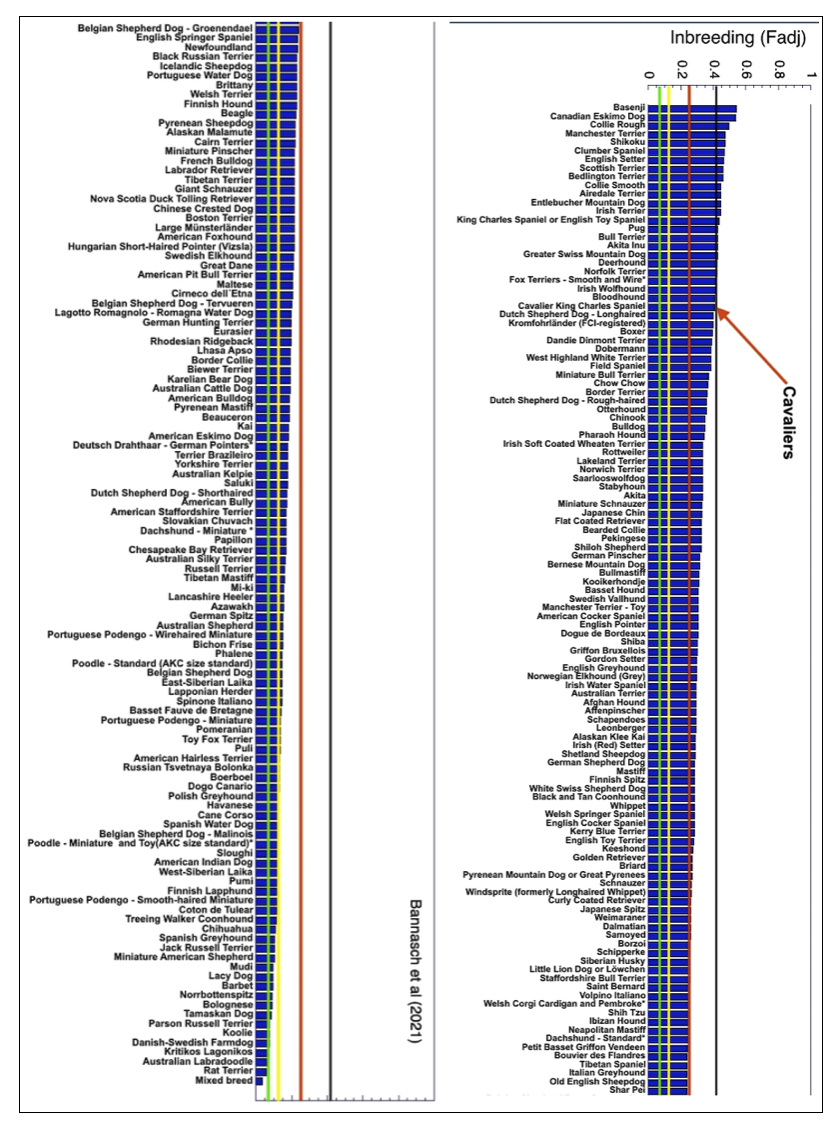|
The public doesn't care if their dog is registered. They don't care how much work and expense goes into breeding. Most don't even care if it's "purebred." And what does "purposefully" mean??? Tested - for what? Most people just want a dog to love. They don't want a dog that will cost them an arm and a leg in vet bills then die in its prime. Or before.
I can see how this FCI video will push the buttons of breeders, touching on favorite memes, but to me it just seems odd and way off the mark. |
You can watch the video HERE. |
|
The common response to criticism about health - and of course I expect it here, again - is that all those unhealthy dogs are coming from backyard breeders and puppy mills. No doubt there are badly bred dogs produced by the unscrupulous. But those dogs are not from a different gene pool than the population of "healthy" dogs.
In fact, like the livestock breeders, puppy mills focus on puppy production and, for that, inbreeding represents a cost they want to avoid. I haven't seen data comparing puppy mill dogs to those from the fancy, but I would be shocked if they had higher inbreeding. At the very least, puppy mills have been selecting strongly for dogs that get pregnant easily without hormone testing and reproductive "assistance", produce large litters without fuss and veterinary intervention, that care for their puppies with minimal assistance, that have adequate milk - in short, the goal is to select for dogs that will produce puppies that at least make it to the consumer. There might be a long list of other health problems, but the puppy mills are selecting for production of puppies that survive past weaning or they would be out of business. If you want to argue that it's the "poorly bred" dogs that are skewing the research and public perception, you need to find some data to prove it, because it doesn't seem very likely to be true.
You will get the PR 100% wrong if it come from within the show dog breeder bubble. Step outside and go talk to the parents sitting at the soccer game. Ask the folks at the dog park why they don't have a purebred dog. Take a poll in some of the Facebook groups that are just about loving and living with dogs. People will not tell you that they're concerned about the registration papers or appreciation of the hard work of the breeder. They're worried about health. They're worried about inbreeding.
|
The heart problems of the Doberman are well documented. I first wrote about them in 2016, and again with responses to that post shortly after, as well as twice in 2017 (here and here). Inbreeding in Dobermans is off the charts (see the figure at the bottom). There's lots of research, testing, and scrutinizing of pedigrees, with no remedy in sight, as well as a huge effort to collect DNA which has apparently produced no information that is useful to breeders. I am not aware of any program that proposes to tackle the issue of inbreeding in Dobermans, without which this the breed is surely doomed. Will nobody save this breed? |
And while we're on the topic of Doodles. The Doodle bashing has to stop. It's nasty, cruel, and looks to the average person like elitism and bigotry. And it is. Is it going to convince anybody to get a purebred dog instead of a doodle? Of course not. Rather, it reinforces the public's opinion of purebred dog breeders as condescending and only interested in looks and show ribbons. Most people are aware that mixed breed dogs have better health and live longer because they are not highly inbred. The average person is horrified to learn that dogs are bred together that are as closely related as full siblings, yet that is common, if not the rule, in many, many breeds. The rebuttals to this from the fancy get the science wrong, and most people don't buy it. (Frequently-heard claims that purebred dogs "are just as healthy" as mixed breed dogs are not supported by the data, and indeed, I'm tired of posting the links to those sources over and over. If you want to dispute the science, go look up the papers.)
Breeders will not change the public's perception of purebred dogs as inbred and unhealthy while denying there's a problem and refusing to fix it. Sure, there are some other serious issues that need to be addressed, not the least of which is the explosion in brachycephalic breeds that wear their health problem for all to see everywhere they go. Breeders are going to have to fix this, like it or not. But you can't fix the ANY health problems if the gene pool lacks the genetic variation necessary to build a healthy dog, and all the dogs are so genetically related that they represent the equivalent of multiple consecutive generations of full-sib crosses.
I've been working with dog breeders to improve the health of purebred dogs through education, consulting and social media, and the provision of tools that can help breeders make better decisions about mate selection. Yet predictably, here we are, facing legislation to force breeders to address physical and genetic health issues, while breeders avoid addressing the elephant in the room that, ultimately, is the cause of all the problems - inbreeding. The kennel clubs and breeders are trying to fix problems without addressing the cause, and they will continue to fail. You simply cannot produce healthy dogs while engaging in unrestricted inbreeding. It can't be done.
Take a step out of the dog fancy bubble. Listen to the people in the real world. The parents at a school function. Your hairdresser. Somebody at the dog park. Your tennis partner. Get outside the bubble. People don't need to be "educated" about what you do; they don't need PR that pushes some value to registration and applauds those hard-working breeders. People really don't care about any of it. They want healthy dogs. That's all. If the purebred dog breeders are not producing them, they will go elsewhere.
Below, the most recent data documenting inbreeding in purebred dogs (from the Bannasch lab at UC Davis). The green line (0.0625) represents the inbreeding produced by a mating of first cousins, yellow (0.125) is mating of half-siblings, and red (0.25) represents a full-sib cross (all of these assume the parents are not inbred). The black line is the inbreeding level of Cavalier King Charles Spaniels (about 40%).
Bannasch et al 2021. The effect of inbreeding, body size and morphology on health in dog breeds. Canine Medicine and Genetics 8:12. https://doi.org/10.1186/s40575-021-00111-4.
ICB's online courses
***************************************
Visit our Facebook Groups
ICB Institute of Canine Biology
...the latest canine news and research
ICB Breeding for the Future
...the science of animal breeding




